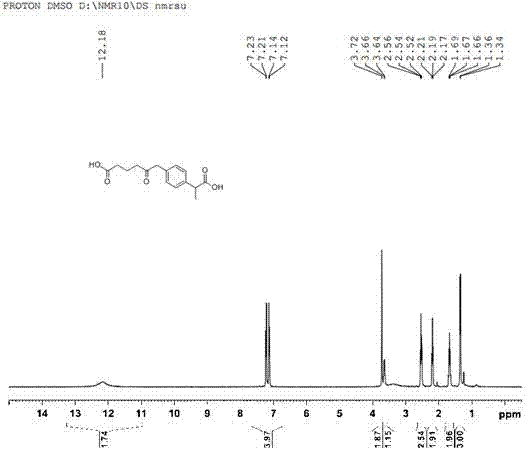Preparation method of loxoprofen sodium ring opened impurity
A technology for loxoprofen sodium and impurities, which is applied in the field of raw material drug preparation, can solve the problems of inability to obtain a compound of formula V and the like, and achieves the effects of good yield, simple process and high purity
- Summary
- Abstract
- Description
- Claims
- Application Information
AI Technical Summary
Problems solved by technology
Method used
Image
Examples
Embodiment 1
[0032] Step (1): Add p-chloromethylisophenylpropionic acid (80g, 0.40mol), hexamethylenetetramine (112.1g, 0.80mol) and 240ml of chloroform into a 500ml three-neck flask, stir and heat up to reflux (63~65°C), stirred and reacted for 6 hours, sampled and plated for complete reaction, cooled to room temperature, added 60g of 36% concentrated hydrochloric acid, stirred and heated to reflux for 2 hours, cooled to room temperature, separated to obtain an organic layer, and the organic layer was washed with saturated carbonic acid Wash with 200 ml of sodium aqueous solution, separate the layers to obtain an organic layer, and concentrate to dryness under reduced pressure to obtain 66.2 g of 2-(4-formylphenyl)propionic acid, a light yellow solid, yield 92.3%, HPLC purity 94.6%. 1 H-NMR (400 MHz, CDCl3)d11.31(1H, s), 9.99(1H, d), 7.86 (2H, d), 7.50(2H,d), 3.84(1H,q), 1.56(3H, d).
[0033] Step (2): Add 4-formyl-phenylpropionic acid (25g, 0.14mol), 1-(4-morpholine)cyclopentene (43g, 0...
Embodiment 2
[0036] Step (1): Into a 500ml three-necked flask, add p-bromomethylisophenylpropionic acid (96.84g, 0.40mol), hexamethylenetetramine (112.1g, 0.80mol), and 240ml of chloroform, stir and heat up to Reflux (63~65°C), stir and react for 6 hours, take samples and spot the reaction completely, cool down to room temperature, add 60g of 36% concentrated hydrochloric acid, stir and heat up to reflux for 2 hours, cool down to room temperature, and separate to obtain an organic layer, which is saturated with Wash with 200ml of sodium carbonate aqueous solution, separate the layers to obtain an organic layer, and concentrate to dryness under reduced pressure to obtain 67.56g of 2-(4-formylphenyl)propionic acid, a light yellow solid, yield 94.2%, HPLC purity 94.6%.
[0037] Step (2): Add 4-formyl-phenylpropionic acid (25g, 0.14mol), 1-(4-morpholine)cyclopentene (43g, 0.28mol) and 150ml toluene into a 500ml three-necked flask, and stir Raise the temperature to reflux (115°C), stir and reac...
Embodiment 3
[0040] Step (1): Add p-chloromethylisophenylpropionic acid (80g, 0.40mol), hexamethylenetetramine (56.05g, 0.40mol) and 240ml of chloroform into a 500ml three-neck flask, stir and heat up to reflux (63~65°C), stirred and reacted for 6 hours, sampled and plated for complete reaction, cooled to room temperature, added 60g of 36% concentrated hydrochloric acid, stirred and heated to reflux for 2 hours, cooled to room temperature, separated to obtain an organic layer, and the organic layer was washed with saturated carbonic acid Wash with 200 ml of sodium aqueous solution, separate the layers to obtain an organic layer, and concentrate to dryness under reduced pressure to obtain 61.4 g of 2-(4-formylphenyl)propionic acid as a pale yellow solid with a yield of 85.6%. HPLC purity was 94.0%.
[0041]Step (2): Add 4-formyl-phenylpropionic acid (25g, 0.14mol), 1-(4-morpholine)cyclopentene (43g, 0.28mol), and 150ml of dichloromethane into a 500ml three-necked flask , stirred and heated...
PUM
 Login to View More
Login to View More Abstract
Description
Claims
Application Information
 Login to View More
Login to View More - R&D
- Intellectual Property
- Life Sciences
- Materials
- Tech Scout
- Unparalleled Data Quality
- Higher Quality Content
- 60% Fewer Hallucinations
Browse by: Latest US Patents, China's latest patents, Technical Efficacy Thesaurus, Application Domain, Technology Topic, Popular Technical Reports.
© 2025 PatSnap. All rights reserved.Legal|Privacy policy|Modern Slavery Act Transparency Statement|Sitemap|About US| Contact US: help@patsnap.com



